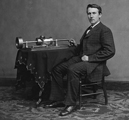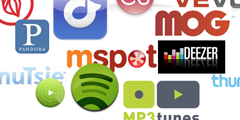 June 18, 2013
June 18, 2013 Think of Your Music as a Service, Not as a Product
 As an independent recording artist, do you think of your music as a service or as a product?
As an independent recording artist, do you think of your music as a service or as a product?
When the phonograph debuted in 1877, the traditional service of music (live performance) was transformed into a product (recordings). This product was stored on physical media — wax cylinders that eventually evolved into vinyl records, 8-tracks, cassettes, CDs, digital downloads, and other formats. This single innovation, through its ability to reproduce recorded sound, forever changed the way we experience music.
It wasn’t long before people started thinking of music as something to own and collect as much as experience. When someone bought an album containing the music of Louis Armstrong or Benny Goodman or Les Paul, they owned it. They could keep it or they could sell it. It was theirs. And they could enjoy and appreciate that music without ever seeing the artist perform it live.
Virtually no one alive today remembers a time before vast, personal record collections, a day when music could be experienced only in the moment in which it was performed. But that is exactly how it was experienced for thousands of years before Edison.
Something surprising is happening in the 21st century. Recorded music is becoming less of a product every day.
Recorded Music Becomes a Service
 In 2000, when digital downloading was gaining steam through Napster and other file-sharing platforms, sales of CDs started a precipitous decline. And they declined throughout the decade, losing more ground each year to iTunes and Amazon and other digital retailers. As the digital snowball grew, consumers learned to think of their music as a non-physical commodity — as digital files on iPods and computers rather than as pieces of molded plastic stacked on shelves. With the advent of music streaming via Rhapsody, Pandora, and Spotify, the transition of recorded music from product back to service was underway.
In 2000, when digital downloading was gaining steam through Napster and other file-sharing platforms, sales of CDs started a precipitous decline. And they declined throughout the decade, losing more ground each year to iTunes and Amazon and other digital retailers. As the digital snowball grew, consumers learned to think of their music as a non-physical commodity — as digital files on iPods and computers rather than as pieces of molded plastic stacked on shelves. With the advent of music streaming via Rhapsody, Pandora, and Spotify, the transition of recorded music from product back to service was underway.
Suddenly you didn’t need to “own” a collection of non-biodegradable products that inefficiently held your favorite music recordings. You could simply pay for a service that granted you access to virtually all of the commercially available recordings in the world.
You could just summon the music whenever you wanted to hear it — in much the same way you might have asked a performer to play your favorite song in a public square in 1840. Or in 1540.
And the physical recordings you owned? Well, they sure did take up a lot of space.
So what does all this mean for you as an independent recording artist?
Performing a Creative Service through Your Recordings
An interesting thing happens when people switch from buying CDs to paying for music-streaming services: the secondary market disappears. There is no equivalent to horse-trading in the streaming world. Your recordings on streaming services are always yours, no matter how many times people enjoy them, no matter how old they get. When someone listens to one of them, you’re paid. Every time.
No question, CDs still make great takeaways along with the merch at your live shows. But if you follow music commerce in 2013, you’re probably not spending too much time selling shiny, little plastic widgets with copies of your recordings on them. Instead, you are allowing your recordings to perform for your audience. When someone spins one of your songs on Rhapsody, you receive a payment of a little under a penny. On Spotify, you get about half a cent. And sure, that will probably never pay the light bill. But the transparent tracking of plays isn’t just about revenue. It’s about knowing how frequently your recording is being played, and understanding the nature and quality of the interactions between you and your audience.
It’s about building that essential relationship.
Streaming is changing the way we experience music. The recordings you’ve released into the world are now standing up and being counted every time they’re played. And their intrinsic value as a creative service performed — original to you — is here to stay.
—
Mark Doyon is principal and creative director of Wampus Multimedia, a record label, publishing imprint, and creative branding agency based in the Washington, D.C. area.
 Developing a Strategy tagged
Developing a Strategy tagged  Music,
Music,  music service
music service 





Reader Comments (1)
True, but it is going slower than you think, depending on the demographics.
If you want ages 11 to 30, streaming is increasing through cell phones.
I think people older than that tend to still use the CD player in their car (where much of music is listened to), and on their CD stereo system at home.
http://www.reverbnation.com/glenngalen